
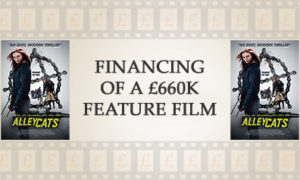 Last year, I shared the full costs and income of a £850k feature film called Papadopoulos & Sons. The article remains popular and has led to a number of people asking me to share similar details of other films. It’s a tricky ask, as the film industry is normally a closed shop and withholds numbers even when there is no obvious reason to do so.
Last year, I shared the full costs and income of a £850k feature film called Papadopoulos & Sons. The article remains popular and has led to a number of people asking me to share similar details of other films. It’s a tricky ask, as the film industry is normally a closed shop and withholds numbers even when there is no obvious reason to do so.
However, every now and then I meet filmmakers who are committed to helping the film community by sharing their journey.
Today’s article covers the film financing of a new feature called Alleycats. The film’s director Ian Bonhôte and its producer Andee Ryder have been kind enough to share with me how they raised two-thirds of a million pounds.
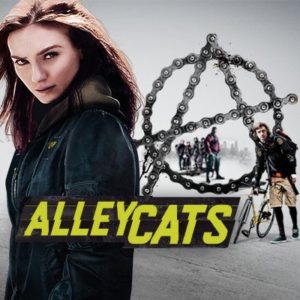 Alleycats is an action/thriller set in the cut-throat world of illegal bike racing (you can read the full synopsis at the end of this article) and it stars Eleanor Tomlinson (Jack the Giant Slayer, The White Queen, Poldark), John Hannah (Sliding doors, The Mummy trilogy and Four Weddings and a Funeral) and Camilla Rutherford (Gosford Park).
Alleycats is an action/thriller set in the cut-throat world of illegal bike racing (you can read the full synopsis at the end of this article) and it stars Eleanor Tomlinson (Jack the Giant Slayer, The White Queen, Poldark), John Hannah (Sliding doors, The Mummy trilogy and Four Weddings and a Funeral) and Camilla Rutherford (Gosford Park).
It was released in the UK this summer (iTunes, DVD & Blu-Ray) and in the last few days in America (via the US iTunes store). It’s also secured distribution deals in Australia, Benelux, France, Greece, Germany, New Zealand, Nordics, South Africa, Spain, Switzerland, Thailand, Taiwan and Brazil, with more in the works.
WE RECOMMEND THE VIDEO: Brahmanandam 2020 New Comedy Movie | South Dubbed Hindi Movies 2020 Full Movie | Action Comedy Movie
Brahmanandam 2020 New Comedy Movie | South Dubbed Hindi Movies 2020 Full Movie | Action Comedy Movie | Brahmanandam.
For both Ian and Andee, Alleycats is a first feature, so the scale and distribution of the film is an impressive feat in an industry which regards having even one first-timer as a liability. This article shares some of the data points and you can also hear them describe their experiences below:
[soundcloud url=”https://api.soundcloud.com/tracks/280295113″ params=”auto_play=false&hide_related=true&show_comments=false&show_user=true&show_reposts=false&visual=false” iframe=”true” /]
The origins of Alleycats
 The journey began eight years ago when Ian directed a music video featuring Alleycat races, urban cycling street races. The Alleycat community is largely made up of bike messengers and has strong punk influences in their attitude and aesthetics. Ian is an avid cyclist and had spotted that the races lend themselves to an exciting city-based action film but on a manageable budget, unlike your average Hollywood action film.
The journey began eight years ago when Ian directed a music video featuring Alleycat races, urban cycling street races. The Alleycat community is largely made up of bike messengers and has strong punk influences in their attitude and aesthetics. Ian is an avid cyclist and had spotted that the races lend themselves to an exciting city-based action film but on a manageable budget, unlike your average Hollywood action film.
The idea of creating a feature film around Alleycats was firmly in Ian’s mind but the technology wasn’t quite ready. Cameras were too big, too heavy and many didn’t produce cinema-quality footage. (I can attest to this myself as I shot a short film featuring Parkour in 2005 and we had to strap a 16mm camera with heavy lenses to the poor performer. Sorry, Dane!) This speaks to just how important timing is in making a feature film. The final Alleycats film was part-funded via Kickstarter and part-shot on mobile / mounted cameras – both of which didn’t exist in the early 2000s.
Not put off by the technical challenges, Ian worked on a draft of the script with co-writer Max Kinnings. Ian submitted an early draft to Film London’s Microwave scheme and, despite getting right the way through to the final stage, it was ultimately not selected. In hindsight, perhaps this was for the best as the budget for Microwave projects are capped at £100,000 and the film’s rejection led to the script improving, the budget growing and the team gaining valuable new members.
Tiny victories led to bigger successes
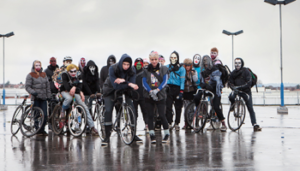 One such vital member of the Alleycats team is Andee Ryder. Andee had been working as a freelance producer for Ian’s company Pulse Films at the time, making short films and music promos. Ian shared his idea for an Alleycats feature and Andee agreed to produce.
One such vital member of the Alleycats team is Andee Ryder. Andee had been working as a freelance producer for Ian’s company Pulse Films at the time, making short films and music promos. Ian shared his idea for an Alleycats feature and Andee agreed to produce.
The pair started to shop their script around town but were met with every filmmakers’ most hated reaction – complete indifference. A common reaction was that people didn’t believe they could pull off the film’s action pieces on the modest budget they were seeking. After a number of months of trying and failing to secure funding, the pair decided they needed to take another route. They used elements of the feature film script to craft an Alleycats short film (co-written by Max Kinnings).
The plan was to prove that Alleycats races were the perfect subject for a thrilling urban action film and that it could be achieved on the budget they were seeking. The pair put in £15,000 of their own money to make the short film. A high price to pay, but the short proved to be an incredibly smart move. It supplied all the proof their wavering backers were after and taught the pair a great deal about how to actually shoot Alleycat races. In addition, the short film provided them with powerful footage and photo stills for their eventual crowdfunding campaign. Few campaigns have the luxury of being able to visually prove the look and feel of their eventual film.
Ian and Andee had boiled their feature film script down to a ten-minute short but for some investors, even this was too long. So they cut a two-minute teaser trailer which they could show in meetings.
This proved to be the vital link in piquing the interest of possible backers. If they liked the two-minute teaser, Andee would send over the short film and the feature film script. If they liked the short, then Andee would seek a commitment for the feature.
Finding the right partner and more development
 With the teaser in hand, Andee was in a much stronger position as he went round the industry seeking partners. The project got the attention of Wayne Marc Godfrey and Robert Jones at The Fyzz Facility, who came on board as Executive Producers. The Fyzz were looking for a project like Alleycats to diversify their slate, which includes BAFTA-nominated The Survivalist and The Foreigner starring Jackie Chan and Pierce Brosnan. As a financier they have also part-funded big productions with the likes of Scorsese, Schwarzenegger and De Niro.
With the teaser in hand, Andee was in a much stronger position as he went round the industry seeking partners. The project got the attention of Wayne Marc Godfrey and Robert Jones at The Fyzz Facility, who came on board as Executive Producers. The Fyzz were looking for a project like Alleycats to diversify their slate, which includes BAFTA-nominated The Survivalist and The Foreigner starring Jackie Chan and Pierce Brosnan. As a financier they have also part-funded big productions with the likes of Scorsese, Schwarzenegger and De Niro.
As the production picked up partners, it became clear that the script could do with a further round of development. Andee was speaking with regional funding body Creative England and their Exec (and long-time producer) Richard Homles provided feedback on the script. In the end, the project couldn’t receive Creative England funding as the film was too London-centric for CE’s regional remit, but the notes proved invaluable.
The Fyzz’s Development Producer Emma Lamont led the development process, and screenwriters Anthea Anka and Simon Uttley joined the team to craft a whole new draft from the original treatment. With an updated script, an industry partner and teaser trailer, Ian and Andee were in a much stronger position.
The film financing model of Alleycats
 To those outside of the film industry, the question “How much will your film cost to make?” sounds like a reasonable, simple question. However, the truth is that there are so many variables. What the script contains, how it’ll be shot, different cast costs, favours, deals – even the time of year will affect the final cost. At various times in its production process, the budget of Alleycats was £350k, £400k, £500k, back down to £450k and finally came to a total of £660k.
To those outside of the film industry, the question “How much will your film cost to make?” sounds like a reasonable, simple question. However, the truth is that there are so many variables. What the script contains, how it’ll be shot, different cast costs, favours, deals – even the time of year will affect the final cost. At various times in its production process, the budget of Alleycats was £350k, £400k, £500k, back down to £450k and finally came to a total of £660k.
As with most feature films, the financing came from a range of sources, and it was Andee’s job to ensure that all of the deals worked in harmony. This includes ensuring that you’re not promising more than 100% of the profits, but also more complex matters such as the order of repayment and level of control over the film.
The film financing of Alleycats came from seven routes:
- Private investors using the SEIS scheme
- Private investors using the EIS scheme
- UK Film Tax Relief
- A post-production deal
- Gap financing
- A crowdfunding campaign
- Completion funding
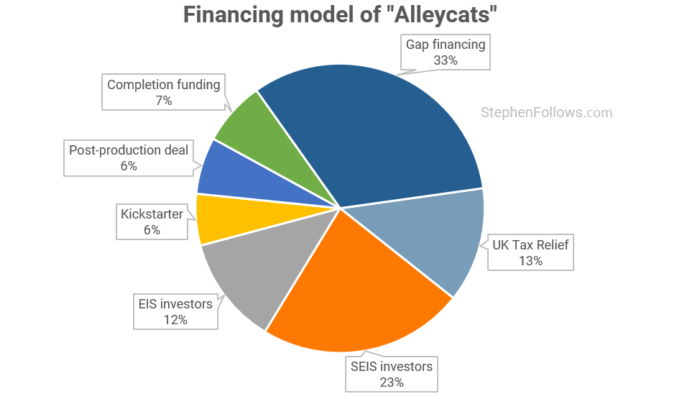
The commercial money: Investors, Loans and Deals
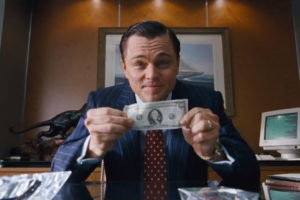 The first money in was via SEIS investors. The Seed Enterprises Investment Scheme is a UK government scheme is which gives significant tax breaks to private investors who put money into early-stage companies. It is designed to support investors and entrepreneurs by reducing the risk to investors and offering big deductions off the investor’s personal tax bill. Under the right circumstances, this can amount to over three-quarters of their original investment. SEIS is widely used by low- and micro-budget filmmakers in the UK, for obvious reasons!
The first money in was via SEIS investors. The Seed Enterprises Investment Scheme is a UK government scheme is which gives significant tax breaks to private investors who put money into early-stage companies. It is designed to support investors and entrepreneurs by reducing the risk to investors and offering big deductions off the investor’s personal tax bill. Under the right circumstances, this can amount to over three-quarters of their original investment. SEIS is widely used by low- and micro-budget filmmakers in the UK, for obvious reasons!
SEIS has a number drawbacks, including limiting how the new companies can operate, who can own them, forcing the investors to wait three years before cashing out and, most crucially, it’s capped at £150,000. This means that Ian and Andee couldn’t use it for more than about a quarter of the money they needed to raise.
The big brother to SEIS is the Enterprises Investment Scheme (EIS), which offers a much lower level of protection for investors (typically just under half their money) but comes with a much higher cap (£10 million). Together, the SEIS and EIS investors made up 35% of Alleycat’s film financing.
Another third of the money came from Gap Financing. These are short-term loans created specifically for films and managed by experts in film finance. Normally, gap financiers are among the last people to come on board a project and their name is derived from the fact they fill the gap between what’s already been raised and what’s needed to shoot the film. The money tends to be relatively expensive and the investor(s) will want to be repaid fully before anyone else sees returns.
The final commercial form of film financing was completion funding, which came from normal private investors who provided money right at the end of the production to get it ready for release.
The exact terms of each investor’s deal are different, which reflects the different realities each faced when they joined the project. For example, early investors were able to get the best tax advantages while the final set of investors were able to see more of the finished film before committing. It’s rarely possible to fund a feature film from just one source, so the challenge becomes matching investors to which risk profile they would prefer. Do they want high risk with possible high returns? Do the tax breaks help their particular private tax situation? Do they want it to be a loan or investment? These types of questions help dictate who comes on board the project and what they get in return for their money.
The “free” money: UK Tax Relief and Crowdfunding
In addition to the commercial investments Ian and Andee gathered, they also received money from two sources which they didn’t need to repay: the UK tax relief and crowdfunding.
The UK Tax Relief scheme rewards British films by giving them a rebate worth just under a fifth of the money they spend in the UK. This is quite a generous scheme and therefore a must for all UK filmmakers. Although productions can claim around a fifth of their budget, the small print of the tax relief means that some costs are excluded. The “eligible spend” only covers pre-production, production and post-production and ignores goods or services given ‘in kind’. In addition, the tax credit is paid after the film is complete, months after the production typically needs to actually spend the money. Therefore, most filmmakers use a specialist investor to cashflow the tax credit, via a short-term loan. This means that in practice, Alleycats received 13% of their £660,000 budget from Tax Relief.
I’ve covered this topic in a number of other articles so I won’t go into any more detail. If you want to read more about UK Film Tax Relief, check out these (How much has the UK government paid in film tax breaks? and UK Tax Credit for Short Films).
As the team were getting close to the main shoot, they realised they were short of some of the money they needed for a big action set piece. They needed more kit, crew and permission to close a road, so they turned to Kickstarter to help them raise the much-needed money.
Footage from the Alleycats short film was included in their Kickstarter pitch video, which you can view below:
[vimeo align=”center” mode=”normal” maxwidth=”700″]
They offered a range of rewards, including a copy of the short film for people giving £5, a DVD of the feature film once complete for £35 right up to an Associate producer credit for anyone giving £5,000.
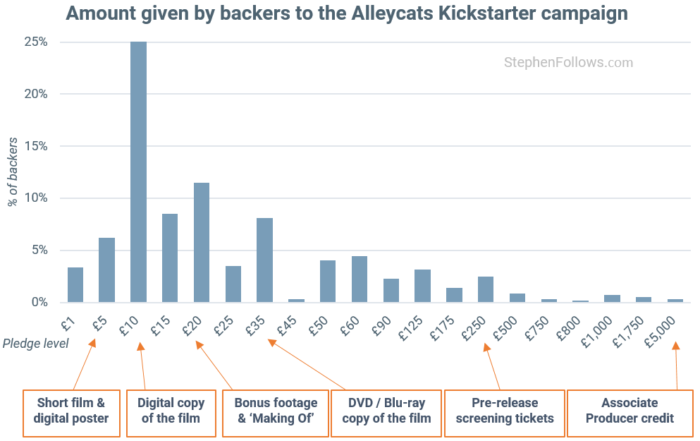
The project lasted for 36 days and took a lot of time from the whole team. You can hear more about what they did to increase donations in the audio interview at the top of this article.
As the chart below shows, money was slow to come in at first. In the first fortnight they had only reached £10,000 of their £50,000 goal but the campaign soon picked up momentum and by the final deadline they had raised 110% of their original goal.
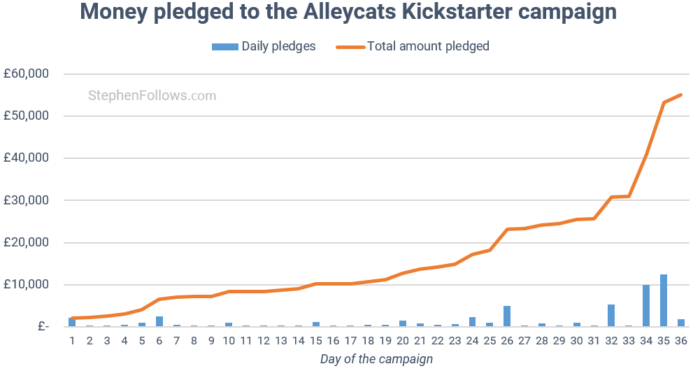
Once the Kickstarter campaign had reached its deadline, the team had raised £55,115. That’s a tidy sum, but is gross so there were a number of deductions which came off the figure before Ian and Andee could put it into the film. These included:
- Kickstarter fee @ 5% = £2,756
- Credit card processing fees = £1,766
- Campaign creation and management costs £7,500
- Creating and supplying rewards to backers = £5,093
- Total = £17,115
This left the production with around £38,000 to go towards the additional scenes. With the financing complete, filming could begin.
In this article I have focused on the film financing aspect, but the production itself was fascinating and Andy and Ian talk more about that in the audio interview. To end this written journey, I want to give you a sense of how they approached the challenge of making an action film on a fraction of a normal action budget. Most films in this genre use a myriad of different film lenses and this can end up being quite pricey for the production to hire. But Ian found a way to save the production money, while also turning a limitation to their advantage:
The lens, we shot most of the film on a 40mm lens, which is a normal lens, almost the closest to our Human POV. So the idea was that we did not want to trick the audience with clever use of lenses but almost put the camera always right in the middle of the action. It is odd to do that for a Genre film, which is obviously all about creating a maximum effect of emotions. But in our case we really wanted to keep the whole film as realistic as possible, mixing the Documentary/ Drama genre with Action/ Thriller.
The other aspect is that we had to build quite a few sets: the Warehouse/ squat, Hotel/ Motel Rooms, Police station…. Daniel Newton the production designer always made sure we could move the walls, to get better shots or angles… But I refused to move anything. If the camera could not fit with a 40mm so we could not shoot there.
Epilogue
It took Ian and Andee seven years to turn their idea into a finished film. Their journey was far from direct, however their hard work and dogged determination has meant that ‘Alleycats’ has already secured distribution deals in fifteen countries (no mean feat for an indie British film) and looks like it’s on its way to being a big success for the pair.
I’m hugely grateful to both Ian and Andee for the time and trust they gave me. We met a few times, they let me interview them on mic for a couple of hours and we exchanged countless emails as I tried to understand every part of the film financing of their production. They were always open, honest and forthcoming for which I am indebted to them.
If you want to say thank you to them then please buy a copy of Alleycats today. It’s on sale in the UK right now (iTunes, DVD & Blu-Ray) and available to order in the US right now (US iTunes).
I want to do more pieces like this as I think new filmmakers should be better informed about what their first feature may involve. If you have a production which would be willing to help other filmmakers, then please drop me a line.
Alleycats synopsis and trailer
 When bike courier CHRIS stumbles across the brutal murder of a young woman whilst delivering a package, he finds himself in danger. Realising that the perpetrator of the crime, YATES, is a well-known Member of Parliament, Chris sets out to blackmail him. But when Chris takes part in an Alleycat Race, an illegal bike race through the city, he is knocked down and killed in a hit-and-run accident – the driver, RIVES, is Yates’ fixer. Chris has been silenced, but there was a witness…
When bike courier CHRIS stumbles across the brutal murder of a young woman whilst delivering a package, he finds himself in danger. Realising that the perpetrator of the crime, YATES, is a well-known Member of Parliament, Chris sets out to blackmail him. But when Chris takes part in an Alleycat Race, an illegal bike race through the city, he is knocked down and killed in a hit-and-run accident – the driver, RIVES, is Yates’ fixer. Chris has been silenced, but there was a witness…
His sister, and fellow racer, DANNI sees Chris get hit and refuses to believe it was a simple accident. Her forceful and impulsive nature aggravates the police, who are slow to investigate and increasingly untrustworthy. So Danni takes matters into her own hands, uncovering bribery and corruption within the courier community and further afield.
As she begins to piece the puzzle together, Danni joins forces with the murdered young woman’s father, REDMAN, and the unlikely pair threaten to uncover the sinister truth behind Chris’s death and the secret his murderers had hoped would die with him. As she becomes increasingly mixed up in a dangerous and violent world, and the body count rises, Danni must push herself to her mental and physical limits in order to find justice for her brother and come through this alive.
12 Comments
[…] Last year, I shared the full costs and income of a £850k feature film called Papadopoulos & Sons. The article remains popular and has led to a number of people asking me to share similar details of other films. It’s a tricky ask, as the film industry is normally a closed shop and withholds numbers even when … […]
Saturday, 12 October 2019